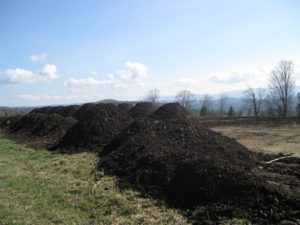
I don’t know about the rest of you, but I celebrated compost week this year by having ten yards of rich, dense compost delivered to my farm. I apply it throughout the season with a particularly big push in the spring. What about the rest of you, how and when do you use compost throughout the season?
While conventional wisdom tells us that compost is generally a good idea, I find that there are still a lot of questions and unknowns floating around about it. Is it better to make your own compost or buy it in? How do you make it? How do you know what to look for when buying it? What is it doing for the garden, anyways?
So, this week we bring you this re-cap on the what, why, and how’s of compost.
What to Use As Compost: Ingredients To Make Compost At Home
 I like to do a combination of buying compost (just make sure to ask it’s origins), as well as make it at home. For step-by-step instructions check out our tutorial. But it’s hard to go wrong as long as you use a good mix of green and brown ingredients, and make sure to mix it up every once in awhile to allow some air into the pile.
I like to do a combination of buying compost (just make sure to ask it’s origins), as well as make it at home. For step-by-step instructions check out our tutorial. But it’s hard to go wrong as long as you use a good mix of green and brown ingredients, and make sure to mix it up every once in awhile to allow some air into the pile.
For Browns:
- Leaves
- Straw
- Dried weeds
- Sawdust
- Old crop material
- Newspaper
For Greens:
- Grass Clippings
- Vegetable and Fruit Scraps
- Coffee Grounds
- Green weeds
- Chicken manure
Ingredients To Leave Out:
- Weeds that have set seed
- Weeds with strong, rhizomous roots
- Visibly diseased plants
- Meat or dairy
Why Compost?
As we all know, in order to grow healthy, vigorous plants we need healthy, vigorous soil. It’s vital that you take some time to prep your soil before any plants go in the ground. Soil with more clay and organic matter in its composition will do wonders for retaining water and keeping your plants satiated. This ability to hold water will help your plants during periods of drought and will greatly reduce your water use in the garden. Compost also helps give you plants that boost of nitrogen as well as a whole range of vitamins and minerals. So, apply it liberally!
How To Add Compost?
There are many ways to incorporate compost into your garden. I’ve slowly been spreading it onto the fields, wheelbarrow by wheelbarrow. My goal is to apply a layer that’s about an inch thick to all parts of the fields, and then till it into the top layer of soil. If a certain crop is an especially heavy feeder (like the sweet peas I just transplanted), then I’ll add a little more.
As we learned in our interview with Caiti from Red H Farm, jumping into a no-till system requires a lot more compost and a new approach. “Before deciding to farm no-till, we would incorporate 10-15 yards of compost into the soil each spring before planting – we typically hire in tractor work, so I would either spread compost first, or spread it after the ground was tilled and use hand tools to incorporate it into beds. Compost is particularly important in our sandy soil to help build organic matter and add nutrients that won’t leach out.”
 But Caiti has moved beyond this 15 yards and now uses compost as almost a mulch. “The specific system we use includes putting a thick layer of compost on each bed and mulching all the pathways with wood chips that we either buy or have dropped off by tree trimmers when they’re working in the area. Each time a bed of crops is harvested and replanted, we add more compost on top to act as a mulch layer.”
But Caiti has moved beyond this 15 yards and now uses compost as almost a mulch. “The specific system we use includes putting a thick layer of compost on each bed and mulching all the pathways with wood chips that we either buy or have dropped off by tree trimmers when they’re working in the area. Each time a bed of crops is harvested and replanted, we add more compost on top to act as a mulch layer.”
Let’s hear it for compost! Now back into the fields, the wheelbarrow awaits!







 Family
Family

